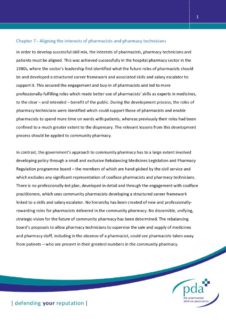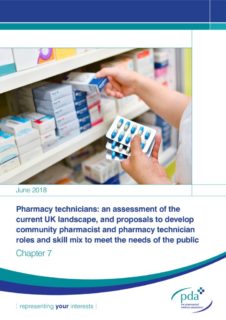In the late ’70s hospital pharmacy leaders created a vision for the role of hospital pharmacists. This involved hospital pharmacists in much more clinical and integrated patient-facing roles. They envisaged then, that hospital pharmacists would be working on wards and have face to face contact with patients enabling the development of clinical relationships and use of their clinical skills.
It was proposed that ultimately, some of the tasks that had previously been the domain of pharmacists – predominantly dispensary-based activities – would need to be delegated to pharmacy technicians. The reliance upon effective skill mix in pharmacy had well and truly arrived.
The process relied upon a skills and salary escalator for both hospital pharmacists and pharmacy technicians with a banded, structured career framework being created. The success of this model of skill mix led to new roles and responsibilities for both hospital pharmacists and hospital pharmacy technicians. It created a route to clinical pharmacy practice, improved professional fulfilment and increased the status of both groups. Aligning the interests of pharmacists and pharmacy technicians to the benefit of both groups and the public was the basis of the successful skill mix model seen in hospital pharmacy today.
Consequently, there is, today, a very substantial difference between hospital and community pharmacy technicians.
Civil servants, policy makers and even some amongst the leadership of the pharmacy profession have not applied the learning from the hospital pharmacy experience to the development of skill mix in the community pharmacy setting. Instead, the pharmacy technicians’ roles in the hospital setting are wrongly being used by some in pharmacy leadership as exemplars and transposed onto discussions about the future of skill mix in the community pharmacy setting.
Crucially, one other fundamental difference between hospital and community pharmacy practice has not been properly considered by those advocating the absence of the pharmacist from a community pharmacy. Hospital pharmacists leave the dispensary and go out on the wards to enjoy their patient-facing clinical roles because that is where they find the patients. In community pharmacies, the patients not only present themselves at the pharmacy, but they expect a pharmacist to be available to them upon arrival.
This is a very important reason as to why such resistance to the notion of operating a community pharmacy in the absence of a pharmacist exists among community pharmacists.
Those who most strongly support the delegation of tasks to community pharmacy technicians and advocate the absence of pharmacists, either come from a hospital pharmacy background and have little experience of working in community pharmacy or those who seek to cut the costs of the community pharmacy operation.
The development of skill mix in community pharmacy must learn the lesson from the successful development in the hospital sector; there are no short cuts. Community pharmacy must first develop a professionally-led plan; a unifying, strategic vision for the future of community pharmacy developed through the engagement with coalface practitioners. This must see community pharmacists developing a structured career framework linked to professional fulfilment and a skills and salary escalator.
This should be led by the interests of patients, including ensuring that patient contact with and access to pharmacists’ clinical expertise in community pharmacy is enhanced.
Only in this way can a symbiotic, complementary skill mix of pharmacists and pharmacy technicians be developed in community pharmacy. This exercise must be led by the profession and not the civil service.
The difference between community and hospital pharmacy technicians must be appreciated and factored into any future policy work on pharmacy skill mix. To reflect the substantial differences between hospital and community pharmacy technicians, the GPhC should annotate the register of pharmacy technicians to reflect the sectoral differences.

